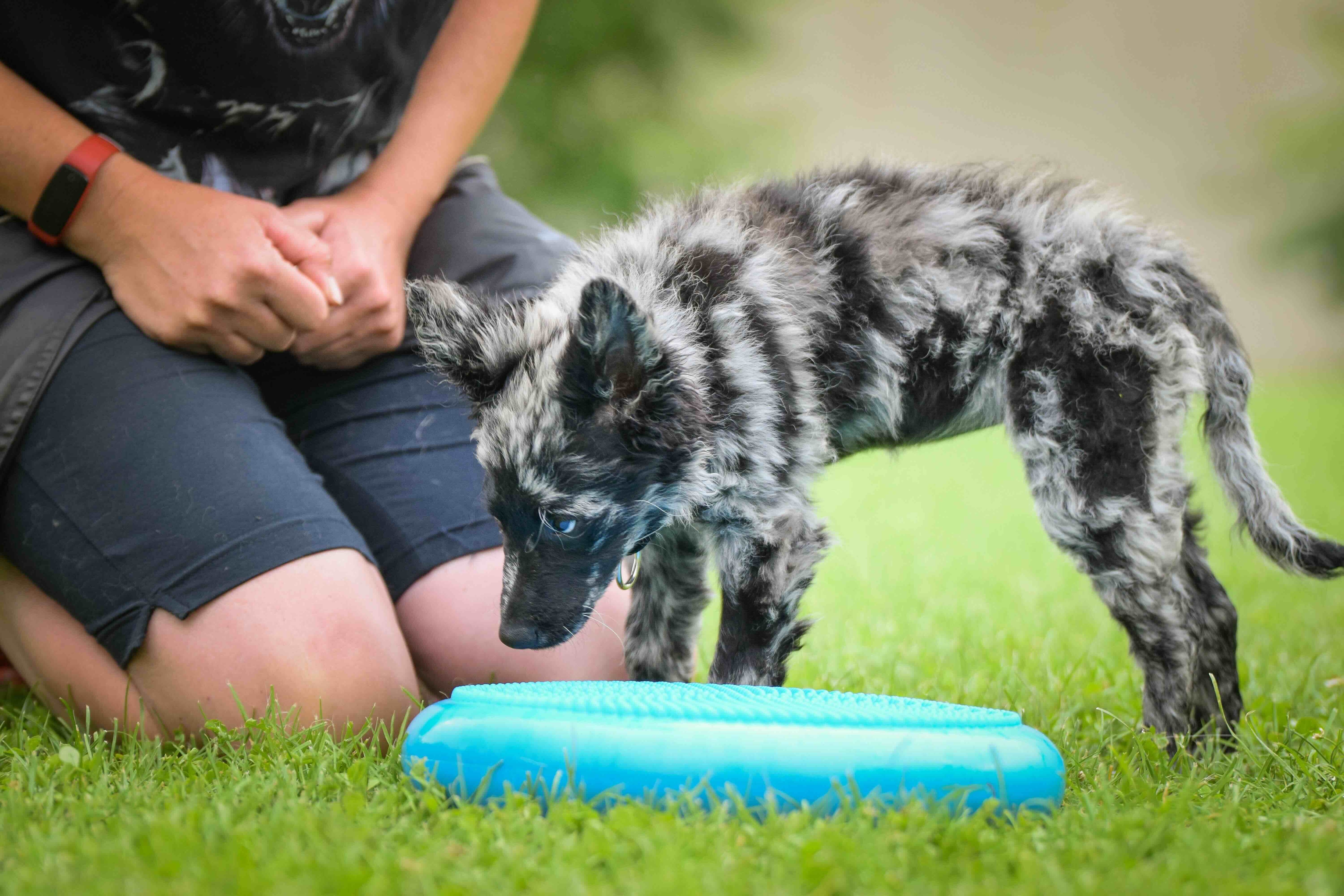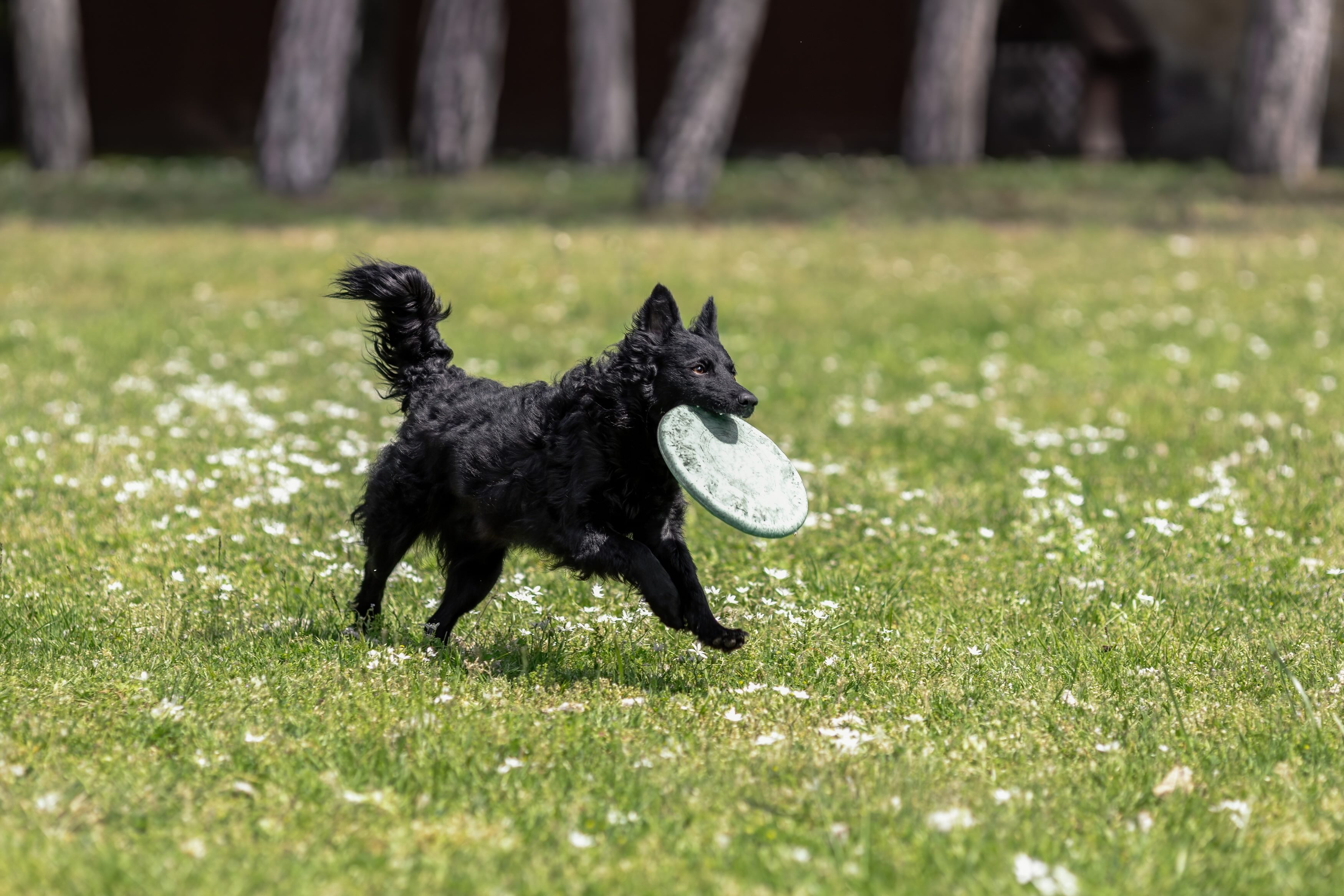Mudi
Adobe Stock/Melissa Keizer
The Hungarian Mudi dog is a herding breed that’s relatively rare outside of their native land. But given the dogs’ athleticism and drive, coupled with American Kennel Club (AKC) recognition in 2022, interest in the breed is growing.
The Mudi (pronounced “moody”) is a medium-sized dog, reaching 15–18.5 inches tall and 18–29 pounds. They have a wedge-shaped head and almond-shaped eyes, and Mudi puppies can be born with a long tail or a natural bobtail.
Mudik (the plural of Mudi) display a range of personality traits, especially because Mudi breeders have primarily focused on breeding the dogs for all-purpose farm duty rather than for companionship or competition. That said, you can expect a Mudi to be active and alert, with an intense interest (and response) to the surrounding environment.
Caring for a Mudi
Mudi dogs are dynamic with colorful personalities. These dogs are not for passive pet parents. Heather Clarkson, president of the Mudi Club of America, describes the breed as “charismatic, tenacious, emotional, vocal, brilliant dogs.”
These high-energy dogs are bred to work, but many are able to settle down at home, a trait Clarkson says helps counterbalance the active nature of the Mudi dog breed.
Expect to spend at least one or two hours a day providing a Mudi with exercise, mental stimulation, and training games. Because of the breed’s intelligence, avoid overly repetitive activities. The time spent exercising and training a Mudi pays off with a tight bond between pet parent and dog.
Mudi Health Issues

The Hungarian Mudi has been bred for work ethic and stamina, so it’s not surprising that the breed is hearty and generally healthy. The breed’s average lifespan is 12–14 years, similar to other medium-sized dogs.
However, like all dogs, Mudik are susceptible to certain health conditions over the course of their life.
Hip and Elbow Dysplasia
Mudi dogs can develop hip dysplasia and elbow dysplasia, in which the hip or elbow joints do not develop correctly as a dog grows. Both conditions cause mobility problems, pain, and arthritis in dogs. Treatment depends on the condition’s severity, but it can range from joint supplements and pain medication to surgery.
The Orthopedic Foundation for Animals (OFA) recommends Mudi breeders have their breeding dogs’ hips and elbows evaluated.
Patellar Luxation
Sometimes Mudi dogs are affected by a luxating patella. This condition causes the kneecap to shift out of place and the dog will usually hold the affected leg off the ground—sometimes very briefly with no other obvious signs of pain. Affected dogs will often kick their back legs out behind them to help relieve their discomfort and relocate the kneecap into place.
Patellar luxation is common for small-breed dogs, but it can be seen in bigger dogs like the Mudi, too. The OFA recommends asking your Mudi breeder for a certificate of clearance from a veterinarian regarding all joint issues.
Epilepsy
Seizures without an underlying cause are sometimes noted within the Mudi breed. Affected dogs may be diagnosed with primary (idiopathic) epilepsy, assuming all other causes of seizures have been ruled out.
If the episodes are recurring, your veterinarian may prescribe a medication that can lessen the frequency or the intensity of the seizures.
Cataracts
While cataracts in dogs can develop as a result of old age, Mudi puppies are sometimes born with cataracts. Left untreated, the condition can affect vision and lead to glaucoma. An eye exam is recommended as part of basic health screening recommendations for the Mudi dog breed.
What To Feed a Mudi
A Mudi should be fed a food appropriate for its life stage (puppy, adult, or senior) that meets nutritional guidelines set by the Association of American Feed Control Officials (AAFCO).
How To Feed a Mudi
Most Mudi dogs do well when eating two meals a day. Mudi puppies may need smaller, more frequent meals. The breed can be susceptible to obesity, so it’s best to measure out each meal and not free-feed.
How Much Should You Feed a Mudi?
The Mudi is an active dog that needs enough calories to support their energetic nature. However, your dog’s specific age, weight, and activity level will determine their actual caloric needs.
Use the feeding guidelines on the dog food that you choose, and ask your vet for advice.
Don’t overlook the caloric impact of training treats or dental chews when calculating your dog’s total calorie intake. Treats shouldn’t make up more than 10% of your dog’s calories for the day.
Nutritional Tips for Mudik
In many cases, dogs fed an AAFCO-compliant diet receive all needed nutrients and don’t require supplementation. But because the Mudi dog breed can be prone to joint problems, a joint supplement may support your dog’s overall health.
It’s best to consult your veterinarian for supplement suggestions.
Behavior and Training Tips for Mudik
Mudi Personality and Temperament

As a herding dog, the Mudi is alert, attentive, and quick to action. Mudi dogs are high-energy with great stamina. To channel that energy, the breed does best when given a job to do or extensive daily exercise.
Herding activities are a natural fit for the Mudi dog breed, but their energy can also be channeled into other dog sports, such as agility. When well-exercised, a Mudi at home is happy to relax and take it easy, making the breed adaptable to living in an apartment or house.
Mudi puppies, like all dog breeds, need socialization from an early age to be comfortable around children, other pets, and new people. But even well-socialized Mudi dogs might prefer the company of a select few people.
“Mudik tend to be ‘one-person’ dogs or ‘one-family’ dogs, and they can struggle to accept strangers sometimes,” says Clarkson. Consistent effort can help condition a Mudi in social situations. But some Mudi dogs are simply more reserved with strangers or unfamiliar dogs, while others will readily greet newcomers.
Mudi Behavior
Mudik are vocal dogs, and they will use a range of noises to communicate with you for attention or during times of play. Mudi dogs will also not hesitate to use their high-pitched bark as an alert response when confronted with unfamiliar people or animals.
“These dogs bond very quickly to the people they know when they are puppies, and without extreme socialization, they will bark at strangers,” says Kim Seiter, an agility dog trainer and Mudi pet parent.
The Mudi’s strong drive and athleticism give these dogs a powerful jump, and they can also be prone to digging. Never leave your Mudi outside unsupervised, and keep them engaged so they don’t resort to digging for entertainment or look for an easy escape.
Remember that all dogs are individuals and that breed only accounts for about 9% of a dog’s behavior.
Mudi Training
The Mudi is a smart dog and an independent thinker, so engage in training activities that are stimulating and varied. Avoid too much repetition, or this breed will lose interest. Reward-based training with treats and toys works best.
“I've never met a dog breed that cares more about fairness and a healthy relationship than a Mudi does,” Clarkson says. “Training and competing are true partnerships for Mudik.”
If you’re looking for a four-legged companion that has the athleticism and drive to partner with you for dog sports and competitions, the Mudi might be your match.
Herding activities are a natural fit for the Mudi dog breed, but their energy can also be channeled into other dog sports, such as agility.
Fun Activities for Mudik
-
Agility
-
Nose work
-
Frisbee
Mudi Grooming Guide
A Hungarian Mudi’s coat can vary from very fine to coarse and rough. Their fur—which comes in colors including black, white, gray, brown, yellow, and merle—is short along their body with a longer mane around their neck, and feathering on the ears and legs.
Skin Care
The Mudi dog breed doesn’t have special requirements for skin care. The breed has a double coat, which repels dirt and insulates the skin.
Typically, frequent bathing is not required, but you may bathe your dog on occasion or if they become very dirty during outdoor activities.
Coat Care
The Mudi’s medium-length coat should be brushed a few times a week to remove debris and tangles, especially in areas where the coat feathers, like behind the legs or ears. However, the coat doesn’t typically require any clipping or trimming, so you won’t need to make regular visits to the groomer for this dog breed.
Eye Care
A Mudi doesn’t usually require special eye care. But when brushing your dog, it’s a good practice to regularly check the eyes for cloudiness, irritation, or discharge. If you notice a change, contact your veterinarian for advice.
Ear Care
The upright ears of the Mudi give a clear view of what’s happening inside your pet’s ears, so keep an eye out for excessive wax buildup or any signs of infection or irritation.
Ask your veterinarian how often you should clean your dog’s ears and which products you need to use.
Considerations for Pet Parents

If you’re thinking about adding a Mudi to your family, “the best pet parent for a Mudi is someone who is active, adaptable, and has a sense of humor,” Clarkson says.
According to Clarkson, the Mudi breed may challenge preconceived ideas on how to raise and train a dog. That can work to the benefit of first-time dog parents “because they don't walk into the relationship with pre-existing ideas of how their dog may act or how training may go—they just accept their dog as they come and meet challenges as they arise,” she says.
On the other hand, the unique nature of the Mudi breed might conflict with an experienced dog parent’s concept of training and cause frustration. Do your research on the breed before bringing home an adult dog or a puppy from a Mudi breeder.
Mudi FAQs
Is a Mudi a good family dog?
For families with the right expectations and enough time and energy to give these dogs an outlet for their energy and intelligence, the Mudi can be a good family dog. They are well-suited for a variety of outdoor activities, and make excellent hiking or jogging partners because of their stamina.
Do Mudi dogs bark?
Yes, the Mudi tends to be a vocal dog breed. “These dogs are alarm barkers, so when there is any change in an environment they are bred to notify that something has changed,” says Seiter.
Are Mudi dogs affectionate?
Hungarian Mudi dogs can be affectionate or aloof, says Seiter. Every dog is an individual, but most Mudik form close bonds to their pet parents and will show them affection.
